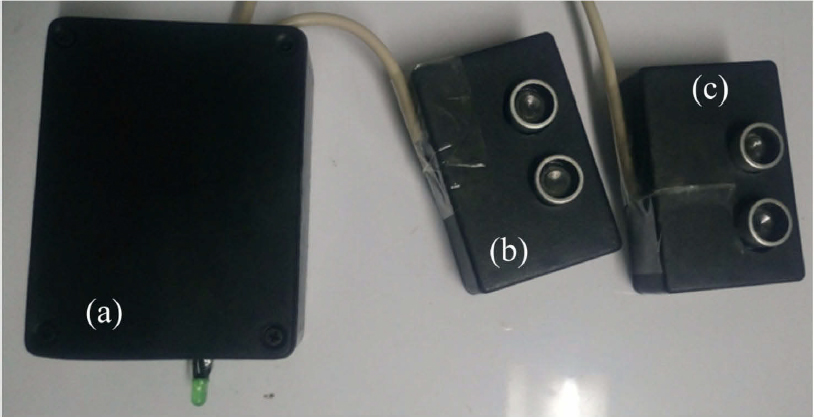Leveraging Existing Traffic Signal Assets to Obtain Quality Traffic Counts: A Guide (2025)
Chapter: 8 Ultrasonic Sensors
CHAPTER 8. ULTRASONIC SENSORS
INTRODUCTION
Ultrasonic sensors detect vehicles by transmitting sound waves at frequencies ranging from 25 kHz to 50 kHz (FHWA, 2022). This frequency range is beyond the threshold of human hearing. Ultrasonic sensors typically include both pulse-based and Doppler-based variants. Most operate using pulse waveforms to measure vehicle count, presence, and lane occupancy (FHWA, 2022). Pulse-based sensors function by emitting ultrasonic signals in bursts and calculating the time it takes for the reflected signals to return to the sensor, enabling accurate detection and measurement. If a vehicle is present, the sound energy returns to the sensor faster than when there is no vehicle. In contrast, Doppler devices emit continuous ultrasonic signals and measure the frequency shift in the reflected signal caused by the motion of a vehicle, based on the Doppler principle. Figure 36 shows a vehicle detection system consisting of a processing unit and two ultrasonic sensors.

Detection using ultrasonic sensors requires that the angle between the sensor and the object is half the dissemination angle. The time it takes to receive reflected ultrasonic waves is directly proportional to the distance between the ultrasonic sensor and the object. Due to ultrasonic waves’ slow speed, the sampling rate is much lower than that of other sensors (e.g., acoustic and magnetic sensors). A shorter detection interval can be applied if more frequent data are needed. However, the detection interval cannot be shortened indefinitely because a detection error will occur if a new ultrasonic wave is emitted before the previous wave has been received (Jo et al., 2014).
STRENGTHS AND WEAKNESSES
Ultrasonic sensors are affordable and straightforward to implement but are better suited for low-cost, localized applications with short-range needs. They are less reliable in challenging environmental conditions and for large-scale, complex intersection layouts compared to other sensors. Table 9 summarizes the main strengths and weaknesses of ultrasonic sensors.
Table 9. Strengths and Weaknesses of Ultrasonic Sensors.
| Strengths | Weaknesses |
|---|---|
| Motorized Traffic Only | |
|
|
In general, ultrasonic sensors are less commonly used for signal control than other sensors. NCHRP Project 03-144 did not validate them because no agency provided data from these sensors.
RECOMMENDED PRACTICES
Recommended practices for ultrasonic sensors are described below.
Installation and Placement
- Strategic mounting: Sensors are mounted at a height and location that ensures clear coverage of the target lanes. Typically, these sensors are placed above traffic lanes on structures such as traffic signal poles, gantries, or mast arms. Typical recommended mounting heights are 12 ft to 18 ft. Ensure the sensors are oriented perpendicular to the road surface to maximize detection accuracy. Misalignment may lead to inaccurate vehicle counts or missed detections.
- Obstruction avoidance: Install sensors where there are minimal obstructions between the sensor and the target lanes to avoid interference. In locations with high volumes of large vehicles, such as buses or trucks, sensor placement must account for potential occlusion, particularly when these vehicles are in adjacent lanes.
- Adequate coverage: Use multiple ultrasonic sensors for intersections or roads with varying lane widths or high traffic volumes. The detection range of each sensor should be aligned with the specific traffic lanes to prevent gaps in coverage. Multiple sensors may also help avoid undercounting or overcounting vehicles in complex traffic environments.
- Reflective interference avoidance: Avoid placing sensors near reflective surfaces (such as metal objects) that could distort the sound waves and lead to inaccurate readings. While ultrasonic sensors are generally resilient to environmental conditions, including rain, snow, and fog, they should be installed in weather-resistant housings to further protect them from harsh weather.
- Temperature considerations: When installing sensors in regions prone to temperature extremes, ensure that they are equipped with temperature compensation features or placed in areas less exposed to direct sunlight or extreme cold. Ultrasonic sensors can be affected by extreme temperature fluctuations, which may alter the speed of sound and impact measurement accuracy.
Calibration and Maintenance
- Regular inspections: Conduct regular inspections to ensure the sensors remain properly aligned with the target lanes. Factors such as wind, vibrations from nearby traffic, or accidental bumps can shift the sensor’s position over time, potentially affecting accuracy. Periodic realignment is essential to maintain optimal performance, particularly in high traffic environments where small misalignments can lead to significant errors.
- Sensor cleaning: Perform routine cleaning of the sensor’s surface to ensure that dirt or grime does not accumulate, especially in areas prone to dust or pollution. Since ultrasonic sensors rely on the transmission and reception of sound waves, dirt, debris, or other contaminants on the sensor surface can interfere with signal transmission.
- Careful calibration: Calibrate sensors during installation to account for local environmental factors such as road surface material, lane width, and typical vehicle speeds. Over time, recalibration may be required if traffic patterns change or if the sensor’s performance begins to degrade. Some sensors may offer automated calibration features to continuously adjust for environmental changes.
- Performance monitoring: Monitor sensors for potential malfunctions, such as signal attenuation or inconsistent readings, which could indicate sensor degradation or interference from external factors. Many ultrasonic traffic sensors are equipped with diagnostic features that allow operators to remotely check the health of the sensor. Routine performance checks should be scheduled to address any early signs of wear or malfunction.
- Interference management: Check for interference from nearby sound sources, such as construction equipment or other sensors operating nearby. During installation, evaluate the site for potential sources of ultrasonic interference and position the sensor accordingly. Additionally, ensure that the sensors are configured to operate on different frequencies or use signal filtering mechanisms to reduce the impact of such interference.


